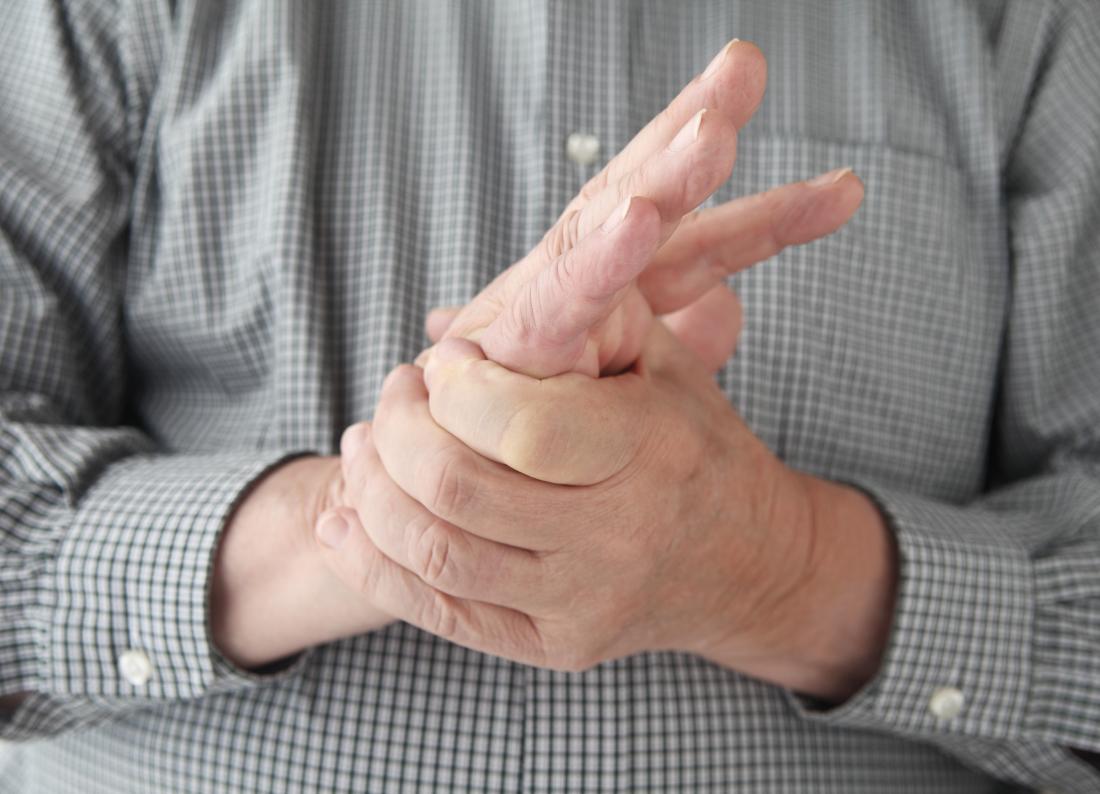Do I have fibromyalgia or rheumatoid arthritis?
Fibromyalgia and rheumatoid arthritis share some symptoms, such as pain and exhaustion. If a person has both conditions, the symptoms may be difficult to distinguish.
However, fibromyalgia and rheumatoid arthritis (RA) are unrelated and have different causes.
While many natural remedies are similar, medical treatments for these conditions are usually different.
In this article, we highlight differences in symptoms and describe the range of home remedies and treatments.
![]() What are the differences?
What are the differences?

Fibromyalgia and rheumatoid arthritis both feature pain and stiffness thoughout the body, but there are some differences.
Fibromyalgia usually causes pain, stiffness, and tenderness in muscles and connective tissues throughout the body. RA tends to cause pain, swelling, and tenderness in certain joints.
Other shared symptoms include:
- pain felt in various parts of the body
- pain mirrored on both sides of the body
- stiffness that is worse in the morning or after long periods of rest
- chronic exhaustion
- reduced mobility and range of motion in muscles and joints
- depression and anxiety
While the effects may be similar, these conditions have different causes.
Fibromyalgia is a chronic neurological condition, which means that it affects the nervous system.
Fibromyalgia changes the way the brain and nervous system process and interpret pain. People with the condition tend to feel amplified pain when they experience everyday injuries, such as strains.
RA is an autoimmune condition. It causes the immune system to harm the synovial tissues, which line the joints. This leads to inflammation and pain.
Over time, RA can cause permanent damage to the bones and connective tissues in the joints. Inflammation may also spread to the lungs, skin, and eyes.
The medical community currently does not believe that fibromyalgia causes inflammation. However, recent research indicates that fibromyalgia may induce a type of inflammation that is not detected by routine blood tests.
No evidence suggests that this inflammation causes joint or muscle damage like RA, and there may be no visible signs.
Do I have fibromyalgia or RA?
While many symptoms are similar, there are usually a few ways to distinguish between fibromyalgia and RA.

Joint pain is a symptom of rheumatoid arthritis, but fibromyalgia pain can affect various body tissues.
Symptoms specific to fibromyalgia include: pain in the tissues of the torso, thighs, buttocks, arms, back, and the back of the head skin that is tender or feels sunburned trigger points that may feel like a hard knot and cause radiating pain when touched widespread pain that impacts more than one part or half of the body gastrointestinal problems, such as diarrhea and constipation dizziness and headaches problems remembering and thinking clearly, sometimes called "fibro fog" very painful menstrual cycles restless leg syndrome sensitivity to temperatures, sounds, and noises symptoms that seem random or are difficult to communicate.
Symptoms specific to RA include:
severe peripheral joint swelling
pain and tenderness that only impacts the joints
pain and tenderness felt equally on both sides of the body
fever
anemia
Can you have fibromyalgia and RA?
Though the conditions are unrelated, having RA may increase a person's likelihood of developing fibromyalgia.
An estimated 20–30 percent of people with RA also have fibromyalgia. Researchers suggest that the chronic inflammation and pain associated with RA may make the nervous system hypersensitive over time, leading to fibromyalgia.
Diagnosis
Fibromyalgia is more difficult to diagnose than RA because fibromyalgia is diagnosed by exclusion. A doctor will test for many other conditions that cause widespread pain, and if none are present, they may diagnose fibromyalgia.
A doctor will usually diagnose fibromyalgia if:
- a person feels pain when the doctor applies pressure to the 18–24 tender points associated with the condition
- symptoms impact all four quadrants of the body
- symptoms have lasted for at least 3 months without a break
Currently, no blood or laboratory tests are used to diagnose fibromyalgia. However, most doctors will order tests, to rule out other conditions, such as arthritis or infection.
If a doctor suspects RA, they will refer the person to a rheumatologist, who specializes in rheumatic conditions. There is no single way to diagnose RA, but the rheumatologist will likely use:
Personal and family medical history. Most people with RA have relatives with the condition, as well as chronic symptoms that impact both sides of the body, primarily the hands and feet.
Blood tests. Many people with RA have signs of inflammation and certain antibodies in the blood. An estimated 80 percent of people with RA test positive for an antibody called rheumatoid factor.
Imaging tests. X-rays and MRI and ultrasound scans can help to determine if the joints have been damaged.
Treatment
Many home remedies and natural treatments for fibromyalgia and RA are similar. However, because the conditions have separate causes, medical treatments are different.
Medical treatments
No medications are specially formulated to treat fibromyalgia, though the FDA has approved the use of some to relieve symptoms.
Medications used to manage fibromyalgia include:
- pregabalin (Lyrica)
- duloxetine (Cymbalta)
- milnacipran (Savella)
It is important for people with RA to be treated early. Treatment often involves medicines that reduce inflammation and slow the condition's progression.
Common medications used to treat RA include:
- Disease-modifying antirheumatic medications
- nonsteroidal anti-inflammatory drugs (NSAIDs)
- corticosteroids
- biological response modifiers
- Home remedies
Taking the following steps at home may help to ease the symptoms of both fibromyalgia and RA:
Rest during flare-ups. When symptoms are at their worst, it often helps to rest the affected areas. Some people find relief by elevating inflamed joints or limbs, reducing blood flow to the area.
Exercise. Symptoms can cause many people to avoid exercise. However, gentle, low-impact exercises that focus on stretching and strengthening muscles and joints can ease symptoms in the long term.
Follow an anti-inflammatory diet. Eating fewer foods that cause inflammation can improve symptoms of both conditions. This means limiting the intake of saturated fats, sugars, red meats, and alcohol.
Hold and cold therapies. Many find that they can ease symptoms by taking long, warm baths and using heating pads and ice packs.
Over-the-counter medications. NSAIDs and pain relieving tablets, creams, and gels can lessen the dull pains associated with fibromyalgia and RA.
Relaxation and mindfulness. These practices often help to improve chronic pain and inflammation.
Establish an emotional support system. People with chronic pain often experience depression and anxiety. A network of family or friends who understand the condition can help to provide support.
Stay positive. People with chronic conditions who try to keep a positive attitude are better able to manage their symptoms in the long term.
Alternative therapies

Complementary therapies for RA and fibromyalgia include massage and aromatherapy.
Many natural and alternative therapies have been shown to improve symptoms of RA and fibromyalgia. These methods include:
Massage
Chiropractic therapy
Acupuncture
Hydrotherapy
Aromatherapy
Osteopathic therapy
Cognitive behavioral therapy
Outlook
Fibromyalgia and RA cause similar symptoms, such as pain, stiffness, fatigue, and decreased mobility.
A doctor or specialist will differentiate between them after taking a detailed history, ordering tests and scans, and performing a targeted physical examination. Some people may have both conditions.
Fibromyalgia and RA cause chronic pain that can be very difficult to live with. Symptoms can impact a person's mood and interfere with everyday activities.
Some people with fibromyalgia seem to benefit from prescription medications. People with RA should seek medical treatment as soon as possible, to slow the progression of the disease and prevent joint damage.
Severe fibromyalgia and RA can become disabling. Many people report a lower quality of life, especially during flare-ups of either condition.
However, making changes to lifestyle, using over-the-counter medications, and trying alternative therapies can often reduce symptoms, making both conditions more manageable.
Speak with a doctor if any symptom, including pain, tenderness, swelling, and stiffness, has lasted longer than 3 months or has occurred without an obvious cause.




Post a Comment